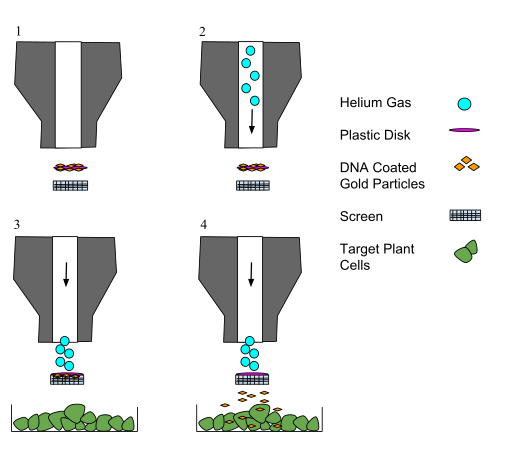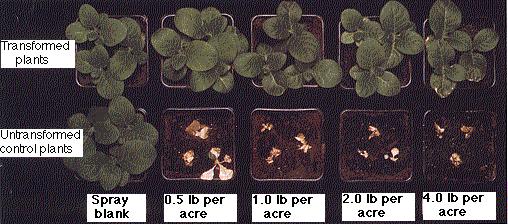11.6: Transgenic Plants
- Page ID
- 4926
\( \newcommand{\vecs}[1]{\overset { \scriptstyle \rightharpoonup} {\mathbf{#1}} } \)
\( \newcommand{\vecd}[1]{\overset{-\!-\!\rightharpoonup}{\vphantom{a}\smash {#1}}} \)
\( \newcommand{\dsum}{\displaystyle\sum\limits} \)
\( \newcommand{\dint}{\displaystyle\int\limits} \)
\( \newcommand{\dlim}{\displaystyle\lim\limits} \)
\( \newcommand{\id}{\mathrm{id}}\) \( \newcommand{\Span}{\mathrm{span}}\)
( \newcommand{\kernel}{\mathrm{null}\,}\) \( \newcommand{\range}{\mathrm{range}\,}\)
\( \newcommand{\RealPart}{\mathrm{Re}}\) \( \newcommand{\ImaginaryPart}{\mathrm{Im}}\)
\( \newcommand{\Argument}{\mathrm{Arg}}\) \( \newcommand{\norm}[1]{\| #1 \|}\)
\( \newcommand{\inner}[2]{\langle #1, #2 \rangle}\)
\( \newcommand{\Span}{\mathrm{span}}\)
\( \newcommand{\id}{\mathrm{id}}\)
\( \newcommand{\Span}{\mathrm{span}}\)
\( \newcommand{\kernel}{\mathrm{null}\,}\)
\( \newcommand{\range}{\mathrm{range}\,}\)
\( \newcommand{\RealPart}{\mathrm{Re}}\)
\( \newcommand{\ImaginaryPart}{\mathrm{Im}}\)
\( \newcommand{\Argument}{\mathrm{Arg}}\)
\( \newcommand{\norm}[1]{\| #1 \|}\)
\( \newcommand{\inner}[2]{\langle #1, #2 \rangle}\)
\( \newcommand{\Span}{\mathrm{span}}\) \( \newcommand{\AA}{\unicode[.8,0]{x212B}}\)
\( \newcommand{\vectorA}[1]{\vec{#1}} % arrow\)
\( \newcommand{\vectorAt}[1]{\vec{\text{#1}}} % arrow\)
\( \newcommand{\vectorB}[1]{\overset { \scriptstyle \rightharpoonup} {\mathbf{#1}} } \)
\( \newcommand{\vectorC}[1]{\textbf{#1}} \)
\( \newcommand{\vectorD}[1]{\overrightarrow{#1}} \)
\( \newcommand{\vectorDt}[1]{\overrightarrow{\text{#1}}} \)
\( \newcommand{\vectE}[1]{\overset{-\!-\!\rightharpoonup}{\vphantom{a}\smash{\mathbf {#1}}}} \)
\( \newcommand{\vecs}[1]{\overset { \scriptstyle \rightharpoonup} {\mathbf{#1}} } \)
\( \newcommand{\vecd}[1]{\overset{-\!-\!\rightharpoonup}{\vphantom{a}\smash {#1}}} \)
\(\newcommand{\avec}{\mathbf a}\) \(\newcommand{\bvec}{\mathbf b}\) \(\newcommand{\cvec}{\mathbf c}\) \(\newcommand{\dvec}{\mathbf d}\) \(\newcommand{\dtil}{\widetilde{\mathbf d}}\) \(\newcommand{\evec}{\mathbf e}\) \(\newcommand{\fvec}{\mathbf f}\) \(\newcommand{\nvec}{\mathbf n}\) \(\newcommand{\pvec}{\mathbf p}\) \(\newcommand{\qvec}{\mathbf q}\) \(\newcommand{\svec}{\mathbf s}\) \(\newcommand{\tvec}{\mathbf t}\) \(\newcommand{\uvec}{\mathbf u}\) \(\newcommand{\vvec}{\mathbf v}\) \(\newcommand{\wvec}{\mathbf w}\) \(\newcommand{\xvec}{\mathbf x}\) \(\newcommand{\yvec}{\mathbf y}\) \(\newcommand{\zvec}{\mathbf z}\) \(\newcommand{\rvec}{\mathbf r}\) \(\newcommand{\mvec}{\mathbf m}\) \(\newcommand{\zerovec}{\mathbf 0}\) \(\newcommand{\onevec}{\mathbf 1}\) \(\newcommand{\real}{\mathbb R}\) \(\newcommand{\twovec}[2]{\left[\begin{array}{r}#1 \\ #2 \end{array}\right]}\) \(\newcommand{\ctwovec}[2]{\left[\begin{array}{c}#1 \\ #2 \end{array}\right]}\) \(\newcommand{\threevec}[3]{\left[\begin{array}{r}#1 \\ #2 \\ #3 \end{array}\right]}\) \(\newcommand{\cthreevec}[3]{\left[\begin{array}{c}#1 \\ #2 \\ #3 \end{array}\right]}\) \(\newcommand{\fourvec}[4]{\left[\begin{array}{r}#1 \\ #2 \\ #3 \\ #4 \end{array}\right]}\) \(\newcommand{\cfourvec}[4]{\left[\begin{array}{c}#1 \\ #2 \\ #3 \\ #4 \end{array}\right]}\) \(\newcommand{\fivevec}[5]{\left[\begin{array}{r}#1 \\ #2 \\ #3 \\ #4 \\ #5 \\ \end{array}\right]}\) \(\newcommand{\cfivevec}[5]{\left[\begin{array}{c}#1 \\ #2 \\ #3 \\ #4 \\ #5 \\ \end{array}\right]}\) \(\newcommand{\mattwo}[4]{\left[\begin{array}{rr}#1 \amp #2 \\ #3 \amp #4 \\ \end{array}\right]}\) \(\newcommand{\laspan}[1]{\text{Span}\{#1\}}\) \(\newcommand{\bcal}{\cal B}\) \(\newcommand{\ccal}{\cal C}\) \(\newcommand{\scal}{\cal S}\) \(\newcommand{\wcal}{\cal W}\) \(\newcommand{\ecal}{\cal E}\) \(\newcommand{\coords}[2]{\left\{#1\right\}_{#2}}\) \(\newcommand{\gray}[1]{\color{gray}{#1}}\) \(\newcommand{\lgray}[1]{\color{lightgray}{#1}}\) \(\newcommand{\rank}{\operatorname{rank}}\) \(\newcommand{\row}{\text{Row}}\) \(\newcommand{\col}{\text{Col}}\) \(\renewcommand{\row}{\text{Row}}\) \(\newcommand{\nul}{\text{Nul}}\) \(\newcommand{\var}{\text{Var}}\) \(\newcommand{\corr}{\text{corr}}\) \(\newcommand{\len}[1]{\left|#1\right|}\) \(\newcommand{\bbar}{\overline{\bvec}}\) \(\newcommand{\bhat}{\widehat{\bvec}}\) \(\newcommand{\bperp}{\bvec^\perp}\) \(\newcommand{\xhat}{\widehat{\xvec}}\) \(\newcommand{\vhat}{\widehat{\vvec}}\) \(\newcommand{\uhat}{\widehat{\uvec}}\) \(\newcommand{\what}{\widehat{\wvec}}\) \(\newcommand{\Sighat}{\widehat{\Sigma}}\) \(\newcommand{\lt}{<}\) \(\newcommand{\gt}{>}\) \(\newcommand{\amp}{&}\) \(\definecolor{fillinmathshade}{gray}{0.9}\)Progress is being made on several fronts to introduce new traits into plants using recombinant DNA technology. The genetic manipulation of plants has been going on since the dawn of agriculture, but until recently this has required the slow and tedious process of cross-breeding varieties. Genetic engineering promises to speed the process and broaden the scope of what can be done.
There are several methods for introducing genes into plants, including infecting plant cells with plasmids as vectors carrying the desired gene and physically shooting microscopic pellets containing the gene directly into the cell. In contrast to animals, there is no real distinction between somatic cells and germline cells. Somatic tissues of plants (e.g., root cells grown in culture) can be transformed in the laboratory with the desired gene and can grow into mature plants with flowers. If all goes well, the transgene will be incorporated into the pollen and eggs and passed on to the next generation. In this respect, it is easier to produce transgenic plants than transgenic animals.

Achievements
Improved Nutritional Quality
Milled rice is the staple food for a large fraction of the world's human population. Milling rice removes the husk and any beta-carotene it contained. Beta-carotene is a precursor to vitamin A, so it is not surprising that vitamin A deficiency is widespread, especially in the countries of Southeast Asia. The synthesis of beta-carotene requires a number of enzyme-catalyzed steps. In January 2000, a group of European researchers reported that they had succeeded in incorporating three transgenes into rice that enabled the plants to manufacture beta-carotene in their endosperm.
Insect Resistance
Bacillus thuringiensis is a bacterium that is pathogenic for a number of insect pests. Its lethal effect is mediated by a protein toxin it produces. Through recombinant DNA methods, the toxin gene can be introduced directly into the genome of the plant where it is expressed and provides protection against insect pests of the plant.
Disease Resistance
Genes that provide resistance against plant viruses have been successfully introduced into such crop plants as tobacco, tomatoes, and potatoes.
Tomato plants infected with tobacco mosaic virus (which attacks tomato plants as well as tobacco). The plants in the back row carry an introduced gene conferring resistance to the virus. The resistant plants produced three times as much fruit as the sensitive plants and the same as control plants.
Herbicide Resistance
Questions have been raised about the safety — both to humans and to the environment — of some of the broad-leaved weed killers like 2,4-D. Alternatives are available, but they may damage the crop as well as the weeds growing in it. However, genes for resistance to some of the newer herbicides have been introduced into some crop plants and enable them to thrive even when exposed to the weed killer.

Effect of the herbicide bromoxynil on tobacco plants transformed with a bacterial gene whose product breaks down bromoxynil (top row) and control plants (bottom row). "Spray blank" plants were treated with the same spray mixture as the others except the bromoxynil was left out. (Courtesy of Calgene, Davis, CA.)
Salt Tolerance
A large fraction of the world's irrigated crop land is so laden with salt that it cannot be used to grow most important crops. However, researchers at the University of California Davis campus have created transgenic tomatoes that grow well in saline soils. The transgene was a highly-expressed sodium/proton antiport pump that sequestered excess sodium in the vacuole of leaf cells. There was no sodium buildup in the fruit.
"Terminator" Genes
This term is used (by opponents of the practice) for transgenes introduced into crop plants to make them produce sterile seeds (and thus force the farmer to buy fresh seeds for the following season rather than saving seeds from the current crop). The process involves introducing three transgenes into the plant:
- A gene encoding a toxin which is lethal to developing seeds but not to mature seeds or the plant. This gene is normally inactive because of a stretch of DNA inserted between it and its promoter.
- A gene encoding a recombinase — an enzyme that can remove the spacer in the toxin gene thus allowing to be expressed.
- A repressor gene whose protein product binds to the promoter of the recombinase thus keeping it inactive.
How they work
When the seeds are soaked (before their sale) in a solution of tetracycline
- Synthesis of the repressor is blocked.
- The recombinase gene becomes active.
- The spacer is removed from the toxin gene and it can now be turned on.
Because the toxin does not harm the growing plant — only its developing seeds — the crop can be grown normally except that its seeds are sterile. The use of terminator genes has created much controversy. Farmers — especially those in developing countries — want to be able to save some seed from their crop to plant the next season. However, Seed companies want to be able to keep selling seeds.
Transgenes Encoding Antisense RNA
Messenger RNA (mRNA) is single-stranded. Its sequence of nucleotides is called "sense" because it results in a gene product (protein). Normally, its unpaired nucleotides are "read" by transfer RNA anticodons as the ribosome proceeds to translate the message.

The second strand is called the antisense strand because its sequence of nucleotides is the complement of message sense. When mRNA forms a duplex with a complementary antisense RNA sequence, translation is blocked. This may occur because the ribosome cannot gain access to the nucleotides in the mRNA or duplex RNA is quickly degraded by ribonucleases in the cell. With recombinant DNA methods, synthetic genes (DNA) encoding antisense RNA molecules can be introduced into the organism.
Biopharmaceuticals
The genes for proteins to be used in human (and animal) medicine can be inserted into plants and expressed by them.
Advantages:- Glycoproteins can be made (bacteria like E. coli cannot do this).
- Virtually unlimited amounts can be grown in the field rather than in expensive fermentation tanks.
- It avoids the danger from using mammalian cells and tissue culture medium that might be contaminated with infectious agents.
- Purification is often easier.
Corn is the most popular plant for these purposes, but tobacco, tomatoes, potatoes, rice and carrot cells grown in tissue culture are also being used.
Some of the proteins that have been produced by transgenic crop plants:- human growth hormone with the gene inserted into the chloroplast DNA of tobacco plants
- humanized antibodies against such infectious agents as
- HIV
- respiratory syncytial virus (RSV)
- sperm (a possible contraceptive)
- herpes simplex virus, HSV, the cause of "cold sores"
- Ebola virus, the cause of the often-fatal Ebola hemorrhagic fever
- protein antigens to be used in vaccines
- An example: patient-specific antilymphoma (a cancer) vaccines. B-cell lymphomas are clones of malignant B cells expressing on their surface a unique antibody molecule. Making tobacco plants transgenic for the RNA of the variable (unique) regions of this antibody enables them to produce the corresponding protein. This can then be incorporated into a vaccine in the hopes (early trials look promising) of boosting the patient's immune system — especially the cell-mediated branch — to combat the cancer.
- other useful proteins like lysozyme and trypsin
- However, as of April 2012, the only protein to receive approval for human use is glucocerebrosidase, an enzyme lacking in Gaucher's disease. It is synthesized by transgenic carrot cells grown in tissue culture.
Controversies
The introduction of transgenic plants into agriculture has been vigorously opposed by some. There are a number of issues that worry the opponents. One of them is the potential risk of transgenes in commercial crops endangering native or nontarget species.
Examples:
- A gene for herbicide resistance in, e.g. maize (corn), escaping into a weed species could make control of the weed far more difficult.
- The gene for Bt toxin expressed in pollen might endanger pollinators like honeybees.
To date, field studies on Bt cotton and maize show that the numbers of some nontarget insects are reduced somewhat but not as much as in fields treated with insecticides.
Another worry is the inadvertent mixing of transgenic crops with nontransgenic food crops. Although this has occurred periodically, there is absolutely no evidence of a threat to human health. Despite the controversies, farmers around the world are embracing transgenic crops. Currently in the United States over 80% of the corn, soybeans, and cotton grown are genetically modified (GM) — principally to provide resistance to the herbicide glyphosate ("Roundup Ready®") thus making it practical to spray the crop with glyphosate to kill weeds without harming the crop and resistance to insect attack (by expressing the toxin of Bacillus thuringiensis).


